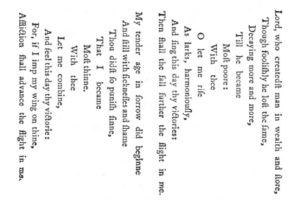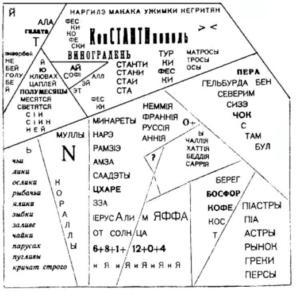I used the term “concrete essay” to describe that piece [“Recorded Lightning”] because instead of combining text and image—the way, say, Claudia Rankine does, or Bianca Stone—the text becomes the image. It’s something that I probably first saw in poetry, then hand-lettered design
-Amaris Ketcham, Winner of Creative Nonfiction Magazine’s “The Weather” essay contest.
The concrete essay is a sub-genre of the visual essay that uses typography to embed a shape or pattern into the piece itself—communicating a message to the reader both visually and textually.
In Amaris Ketcham’s award-winning concrete essay, “Recorded Lightning,” the text is formatted in sections to create the image of a single lightning strike down the page. Ketcham “drew” jagged lines of apportioned white space to outline grey font in the centre panel contrasted with black font on either side. (View a sample of the Ketcham’s essay).
There’s much to love about Ketcham’s concrete essay, which was selected as the winner of Creative Nonfiction magazine’s weather-themed essay contest in 2016. What I love about this piece—and this visual storytelling form—is its power to create a deeper, lasting impression on a reader.
When the reader walks away, she will remember both what she read and saw.
***
Humans have long communicated in ways that combine language and image. Ancient civilizations in different parts of the world communicated pictorially, developing symbols to represent objects and ideas. The Egyptians had hieroglyphics. The Greeks used pictographs. The Chinese, logograms.
Pattern poetry was a later evolution, with some of the earliest examples attributed to 17th century Welsh poet, George Herbert—a typographic formalist who recognized that the structure of a poem could reinforce the text’s message by its shape.

“Easter Wings” by George Hebert, published in 1633.
What became known in the early 20th century as “concrete poetry” originated with Russian Futurist poet, Vasily Kamensky. Kamensky described his 1914 poetry collection, Tango with Cows, as “ferro-concrete poems”—words poured in a concrete mold to reinforce their message, setting the poems in stone.

“Constantinople” by Vasily Kamenski, published in 1914.
Kamensky’s famous aerial view of “Constantinople” depicts neighborhoods, architectural landmarks, and the city’s inhabitants in Cyrillic text of varying fonts and sizes. Scott W. Palmer calls Kamensky’s poetic illustration a “literal word map”—one that makes perfect sense considering its author was an experienced aviator.
***
As creative nonfiction (CNF) writers, eager to explore, stretch, and push the genre’s limits, it’s inspiring to see the ways literature can edge into the realm of the graphic.
If you’d like to start playing with text and image in your work, follow these tips for writing a concrete essay:
- Start with a thing. Choose an object to write about or select one significant object embedded in an existing essay. How might the thing in some way dictate the shape of your piece?
- Check out page samples of Sarah Minor’s concrete essays “Mississippi Pearl,” “Vide,” and “Nest” on her website for ideas and inspiration. Take a look at Jennifer Wortman’s “Worst Case Scenario” and the visual essays published by The Diagram.
- Be warned: trying to get a word processing program to act like a design application can be frustrating and time consuming. This Writer’s Digest article by Michael J. Vaughan offers tips for formatting a concrete poem that can also be applied to creating a brief concrete essay.
To learn more about textual and visual storytelling forms for CNF writers, check out my craft article, Let’s Get Graphic.
Further Reading:
- “On Abstract Text and Concrete Object: An Interview with Amaris Ketcham” on Essay Daily
- “Hattie Fletcher on CNF and Amaris Ketcham’s Recorded Lightning” on Essay Daily tips
 Nicole Breit is a poet, essayist, and online writing instructor who lives on British Columbia’s gorgeous Sunshine Coast. Her lyric essay, “An Atmospheric Pressure”, won Room magazine’s CNF contest in 2016 and was selected as a Notable Essay by the editors of Best American Essays 2017. Visit Nicole’s website to learn more about her genre-bending CNF e-courses. The next session of Nicole’s e-course on the visual essay starts November 5. For more info or to register, visit the Spark Your *Visual* Story landing page.
Nicole Breit is a poet, essayist, and online writing instructor who lives on British Columbia’s gorgeous Sunshine Coast. Her lyric essay, “An Atmospheric Pressure”, won Room magazine’s CNF contest in 2016 and was selected as a Notable Essay by the editors of Best American Essays 2017. Visit Nicole’s website to learn more about her genre-bending CNF e-courses. The next session of Nicole’s e-course on the visual essay starts November 5. For more info or to register, visit the Spark Your *Visual* Story landing page.


